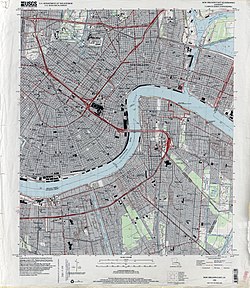
Saint Louis Cemetery is the name of three Catholic cemeteries in New Orleans, Louisiana. Most of the graves are above-ground vaults constructed in the 18th and 19th centuries.
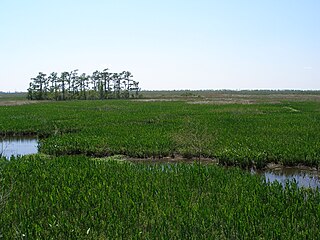
Jean Lafitte National Historical Park and Preserve protects the natural and cultural resources of Louisiana's Mississippi River Delta region. It is named after French pirate Jean Lafitte and consists of six separate sites and a park headquarters.

Chalmette National Cemetery is a United States National Cemetery located within Jean Lafitte National Historical Park and Preserve in Chalmette, Louisiana. The cemetery is a 17.5-acre (7.1 ha) graveyard adjacent to the site that was once the battleground of the Battle of New Orleans, which took place at the end of the War of 1812. Despite its proximity to the site of the Battle of New Orleans in the War of 1812, the majority of the interments are of soldiers who were casualties or veterans of the American Civil War, the Spanish-American War, World War I, World War II, the Korean War, or the Vietnam War. The cemetery was subsequently closed to new interments.
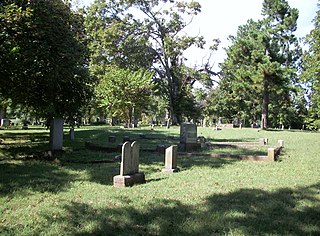
Evergreen Cemetery, located at William and University Streets in Fayetteville, Arkansas, is one of the largest early historic cemeteries in the region, with burials dating to 1838. Evergreen is included in the National Register of Historic Places for its age, and because numerous important historical figures are buried there. These include Senator J. William Fulbright, Governor Archibald Yell, educator Sophia Sawyer, industrialist Lafayette Gregg, and many others.

Greenwood Cemetery is a historic rural cemetery in New Orleans, Louisiana. The cemetery was opened in 1852, and is located on City Park Avenue in the Navarre neighborhood. The cemetery has a number of impressive monuments and sculptures. It is one of a group of historic cemeteries in New Orleans.

Camp Moore, north of the Village of Tangipahoa near Kentwood, Louisiana, was a Confederate training base and principal base of operations in eastern Louisiana and southwestern Mississippi. The base was named for Louisiana Governor Thomas Overton Moore. It operated from May 1861 to 1864 during the American Civil War. Confederate monuments were erected at the cemetery and on the grounds in the early 20th century.

The Old Louisiana State Capitol, also known as the State House, is a historic government building, and now a museum, at 100 North Boulevard in Baton Rouge, Louisiana, U.S. It housed the Louisiana State Legislature from the mid-19th century until the current capitol tower building was constructed from 1929-32.

Eugene Pioneer Cemetery is a pioneer cemetery in Eugene, Oregon, United States. It is one of the three oldest cemeteries in Eugene. It is the largest in both acreage and burials encompassing 16 acres (65,000 m2) with approximately 5,000 burials.

North Burial Ground is a historic cemetery located on North Main Street between Brightman and Cory Streets in Fall River, Massachusetts, United States. The cemetery was established in 1810 and added to the National Register of Historic Places in 1983. It is the oldest city-owned cemetery in Fall River.

Fort Belle Fontaine is a former U.S. military base located in St. Louis County, Missouri, across the Mississippi and Missouri rivers from Alton, Illinois. The fort was the first U.S. military installation west of the Mississippi, in the newly acquired Louisiana Territory, and served as a starting point for many expeditions to the American West.

This is a list of the National Register of Historic Places listings in Orleans Parish, Louisiana.
Albert Weiblen (1857–1957) was a German-born American architect and sculptor. His company, the Albert Weiblen Marble and Granite Company, was based in New Orleans and specialized in monuments and burial structures.
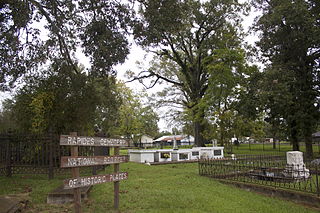
Rapides Cemetery is a historic burial ground located in Pineville, Louisiana at the site of the colonial era Post of Rapides.

The Odd Fellows and Confederate Cemetery, at the corner of Cemetery and Commerce Streets in Grenada, Mississippi is a historic cemetery. It includes Gothic architecture, Romanesque architecture, Classical architecture. It was listed on the National Register of Historic Places in 1988, for architectural criteria.

The Odd Fellows Cemetery in Starkville, Mississippi is a historic, 3-acre (1.2 ha) African-American cemetery that was listed on the National Register of Historic Places in 1990.

Bothell Pioneer Cemetery is a cemetery located in Bothell, Washington.

The Pioneer and Military Memorial Park is the official name given to seven historic cemeteries in Phoenix, Arizona. The cemeteries were founded in 1884 in what was known as "Block 32". On February 1, 2007, "Block 32" was renamed Pioneer and Military Memorial Park. The Pioneer and Military Memorial Park is listed in the National Register of Historic Places. The historic Smurthwaite House, which is also listed in the National Register of Historic Places, is located on the grounds of the Pioneer and Military Memorial Park and is used as the cemetery's main office. Pioneer and Military Memorial Park is the final resting place of various notable pioneers of Arizona.
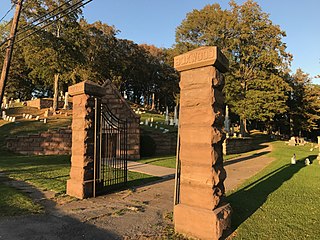
Boxwood Cemetery is a historic rural cemetery located at Medina in Orleans County, New York. The cemetery was established in 1849, and is the resting place of many early settlers. The cemetery includes approximately 5,000 marked burials in the cemetery, spanning from 1849 until the present day. It features entrance ways flanked by Medina sandstone columns and wrought-iron gates built in 1925. Located in the cemetery is a Gothic Revival style chapel built in 1903 of rough-cut red Medina sandstone.

The Historic Cemeteries of New Orleans, New Orleans, United States, are a group of forty-two cemeteries that are historically and culturally significant. These are distinct from most cemeteries commonly located in the United States in that they are an amalgam of the French, Spanish, and Caribbean historical influences on the city of New Orleans in addition to limitations resulting from the city's high water table. The cemeteries reflect the ethnic, religious, and socio-economic heritages of the city. Architecturally, they are predominantly above ground tombs, family tombs, civic association tombs, and wall vaults, often in neo-classical design and laid out in regular patterns similar to city streets. They are at times referred to colloquially as “Cities of the Dead”, and some of the historic cemeteries are tourist destinations.

